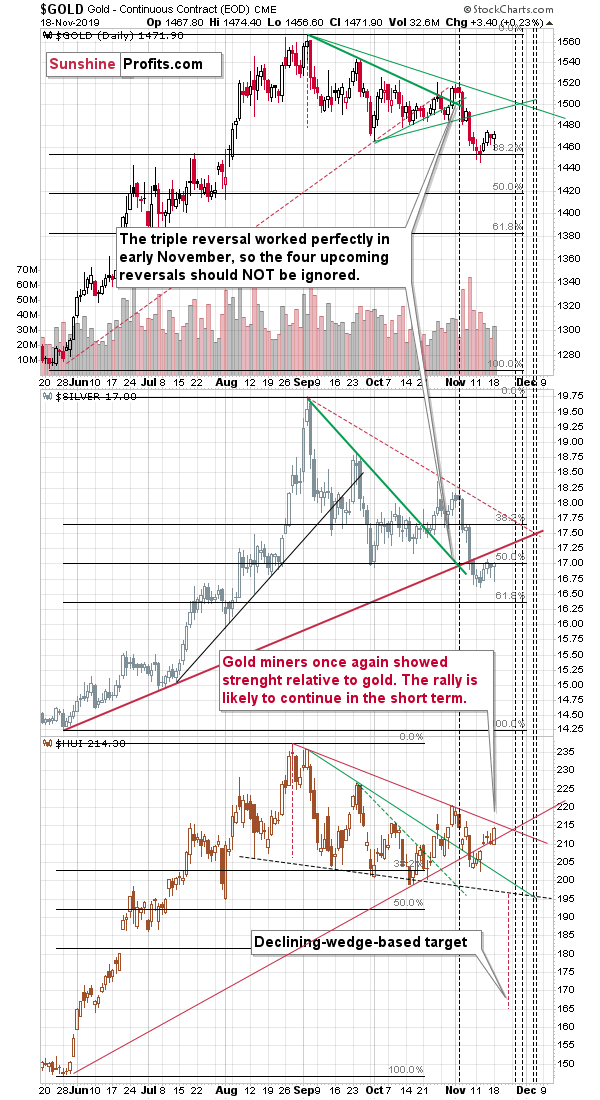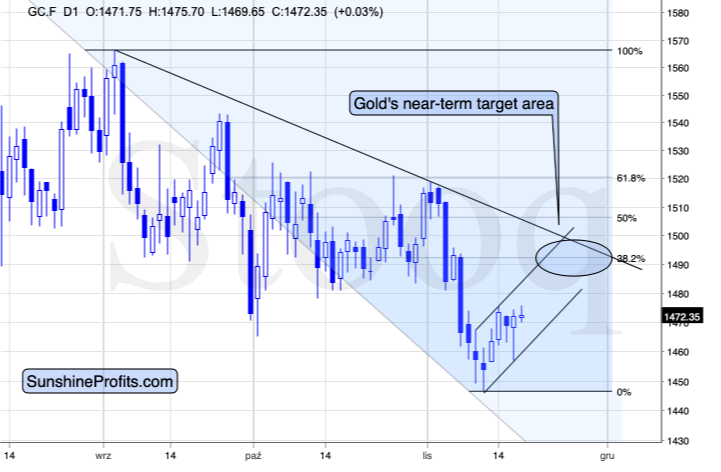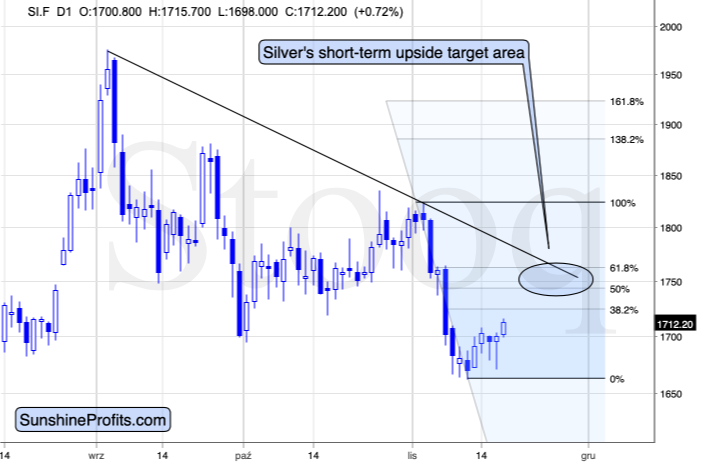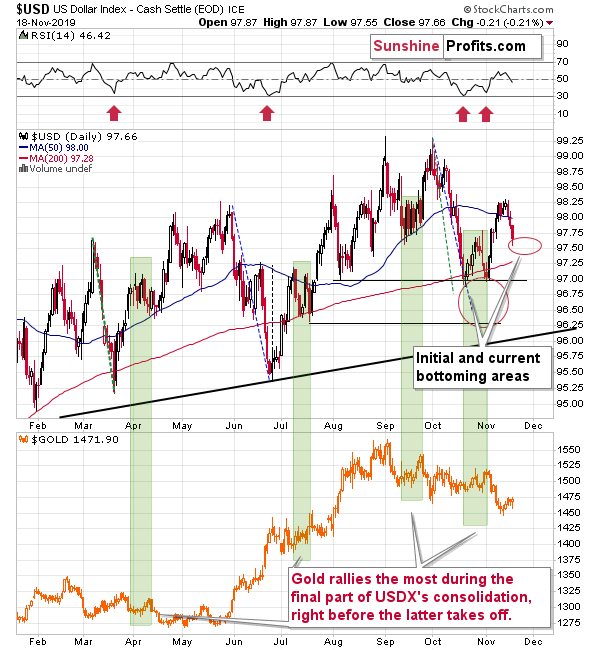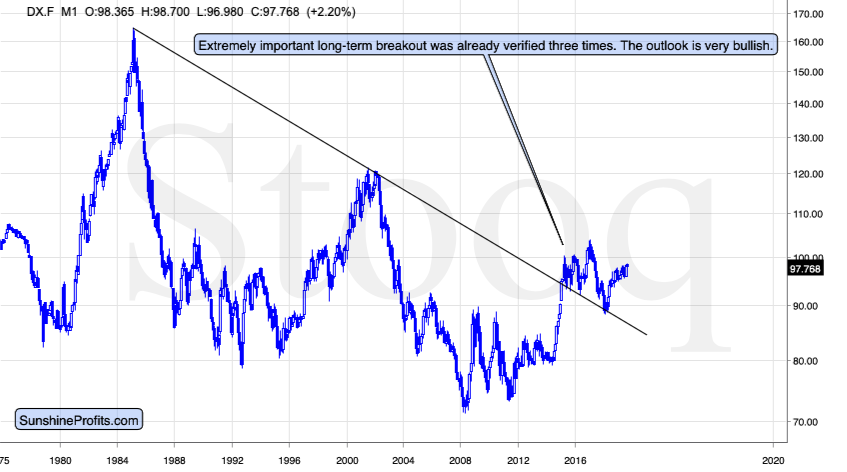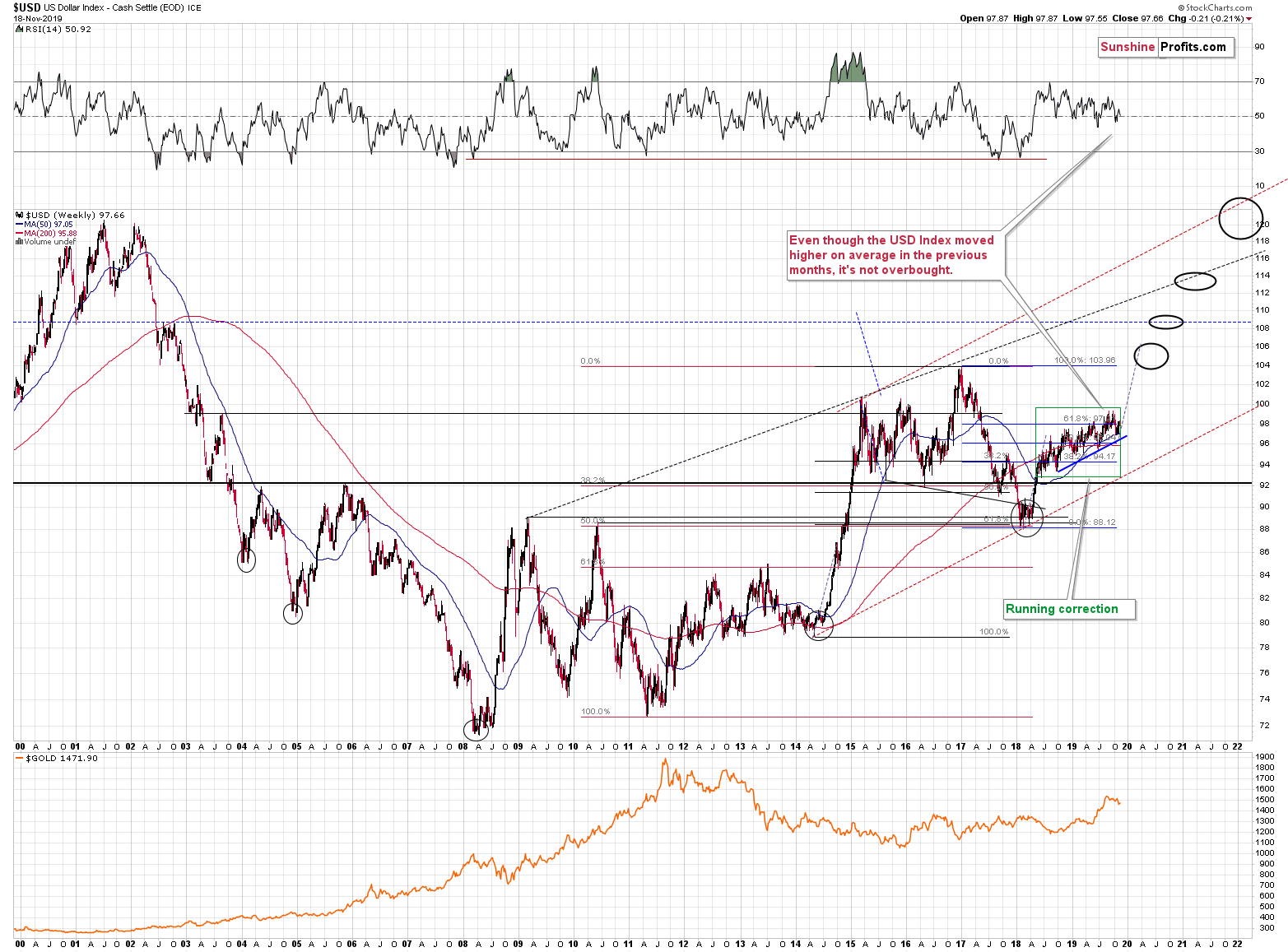Briefly: in our opinion, small (50% of the regular size of the position) speculative long positions in gold, silver, and mining stocks are justified from the risk/reward point of view at the moment of publishing this Alert.
Yesterday, we warned you that the zig-zag in the yellow metal was not as bearish as it appeared at first sight and that it was likely a rather normal correction within a short-term (and short-term only) uptrend. Shortly thereafter, gold rallied back with vengeance and ultimately closed the session in the green. Miners moved above the recent highs and silver is rallying to new highs in today's pre-market trading. Let's take a look at the details.
The Short-Term in PMs
The rally in gold may caught the most interest from traders, but it was yesterday's rally in the miners, and it is today's rally in silver that have more important implications.
Gold miners tend to be strong relative to gold during rallies, especially in a given rally's early part. That's exactly what we saw yesterday. After a brief pause, miners resumed their rally and moved above the most recent highs, even though gold itself didn't. That's a subtle, yet important - sign of strength.
Since miners are outperforming gold and silver particularly well in the initial part of a rally (and silver catches up relatively close to the end of the rally), yesterday's performance suggests that the rally has still some steam left in it. That's very good, because - while our long positions are already profitable - it means that the profits are likely to become even bigger and that those who missed the buying opportunity can still join in.
Silver's short-term outperformance will be one of the things we'll be looking at in order to confirm the end of this short-term rally. At the same time, it might imply a great shorting opportunity.
At this time, you might be wondering if silver's pre-market upswing (at the moment of writing these words, silver is up by $0.10 while gold is more or less flat) is already the sign that we were waiting for. The short answer is "no". The outperformance is too insignificant so far and it would be best if at the same time silver outperformed gold and miners underperformed it. In this way, both signals would confirm each other.
The same thing can be observed from the more long-term point of view. Most of gold miners' gains that you can see on the above chart happened between May and late June. However, in case of silver, most gains took place between early August and early September. It works from the long-term point of view as well. Remember how silver and gold miners performed about 10 years ago?
Taking the 2008 bottom as the starting point, the vast majority of gains in the gold miners happened before the end of 2009. In case of silver, however, the rally really picked up in mid-2010 and ended with a blast in 2011. Knowing how to move between these markets could have made very big profits while one stayed long precious metals for the entire time. On a side note, we dedicated a big research report to this phenomenon, in which we called the above strategy buy-and-hold on steroids. Cheesy name? A bit. Profitable? You bet. Interestingly, we know no fund managers with this specific approach to long-term precious metals investing (well, other than your truly, that is).
Moving back to the short term, knowing the dynamics between silver and mining stocks should be helpful in pinpointing the next turnaround. We already have quite a few indications of when and at what price the turnaround will likely take place and when we'd take profits off the table, but the above is likely to serve as a valuable confirmation.
To be clear, here are the most likely target areas for gold and silver:
As a reminder, gold and silver could rally higher, but betting on a move even above the above target areas would carry too much risk in our view i.a. due to the reasons that we outlined yesterday. So, instead of trying to pinpoint the exact top, our focus is on getting the optimal exit with regard to the risk to reward point of view.
There's one more thing that we would like to discuss in today's Alert, and that is the situation in the USD Index and its relationship with gold.
It's the USD Index Again
We previously commented on the above USD Index chart in the following way:
The breakdown below the very short-term rising wedge pattern resulted in a major decline. "Major" from the very short-term point of view as the following daily downswing has been the biggest daily decline that we saw this month. After the initial decline, the move lower continued and the USDX closed the week below its 50-day moving average. The 50-day MA has been providing support quite reliably in the previous months. It was not always strong support, but often meaningful enough to make it useful as a trading tool. While it stopped the decline on Thursday, the USDX broke below it overall.
The above breakdown opened the way to even lower USDX values.
The green and blue dashed lines represent declines that are similar to the October decline. The rallies that followed them were quite sharp, but they too had smaller pauses within them. Both: March-April, and July rallies consolidated after the USDX moved above its 50-day moving average.
The short-term decline that we saw so far doesn't compare to what we saw in early April and in mid-June. Consequently, the odds are that the USD Index will decline some more before soaring to new highs.
This means that gold is likely to move higher before plunging. Consequently, the odds are that reports of gold turning bearish for the short run are premature.
Now, since the USD Index already moved to our target area, there comes the question of whether this is likely to translate into a top in gold or not. Our answer is that it indicates that the top is relatively close, but not necessarily in yet.
You see, the link between gold and the USD Index is not as straightforward at it may appear at first sight. People will usually expect gold to move higher on the same day when the USD Index moves lower and vice-versa. And it quite often happens in this way. However, the strength of reaction varies. In fact, it could vary so much that moves in the USDX are going to be mostly ignored once the day-to-day price noise is filtered out.
In today's Alert, we will focus on the very specific part of the gold-USD dynamics - on gold's behavior during USD's consolidations. And more precisely, what happens if the USD Index continues to move sideways for a while and soars only after some time.
After all, that's exactly what could happen right now. The USD Index has already moved to our target area, but it doesn't automatically mean that the next upswing has to start immediately. In fact, pauses before rallies were quite common in the previous months. We marked those cases with green rectangles.
There were four similar cases this year. In two cases, the USDX consolidated after rallying and in two cases, it consolidated after declining. And yet, as far as the consolidation itself is concerned, we see the same kind of reaction in gold in all four of them.
Gold rallied most visibly when the consolidation in the USD Index was ending.
This is profound, because it means that the USD Index doesn't have to slide from here for gold to move higher in the next several days. The USD Index might move back and forth (perhaps slightly higher or slightly lower) and gold could form the final short-term pop-up just like it did in mid-April, mid-July, late-September, and late-October. In other words, our USD Index analysis doesn't invalidate our gold analysis.
Of course, if the USD Index declines some more, then gold would likely rally anyway.
That's the outlook for the short term and the short term only. After it's all said and done and the dust settles, the USDX is likely to resume it's medium- and long-term trends.
And that's where the golden picture becomes gloomy.
The USD Index is after a massive long-term breakout and its verification. This makes a medium- or long-term rally very likely. The previous similar rallies resulted in big drops in the value of gold (such as in the early 80s and in the second half of the 90s).
Based on the above chart, it's easy to imagine how the USDX can rally to the 120 level or so. As we zoom in and the proper context disappears, it starts to look "unreasonable".
The 120 level seems very high - as something almost unachievable. And no wonder - the USD Index has been trading below 100 for almost 18 years (with a few relatively brief exceptions). Yet, the confirmed breakout from the previous chart is an undeniable fact, and both: USD Index and the precious metals market are likely to be affected by it.
Looking at the last 1.5 years of USDX performance from the short-term point of view make it seem like nothing really happened - it looks like a horizontal back-and-forth action. The above chart, however, clearly shows that it's actually a running correction - a pause after a strong rally during which the USD Index moves on average higher anyway. The "correction" here means that the pace at which USD rallied simply declined.
The outlook for the following months - and quite likely years - is bullish for the USD Index. To be clear, the above doesn't mean that gold has to continue declining as long as the USD Index rallies. Just as the USD Index bottomed (2008) well before gold topped (2011), we are likely to see something opposite in the following months. At some point, gold is likely to stop reacting to USD's rally and start to move higher on its own. We are likely months away from this situation, though.
Naturally, the key bearish factors for the medium term remain intact - the outlook became bullish only for the short term.
Key Factors to Keep in Mind
Critical factors:
- The USD Index broke above the very long-term resistance line and verified the breakout above it. Its huge upswing is already underway.
- The USD's long-term upswing is an extremely important and bearish factor for gold. There were only two similar cases in the past few decades, when USD Index was starting profound, long-term bull markets, and they were both accompanied by huge declines in gold and the rest of the precious metals market
- Out of these two similar cases, only one is very similar - the case when gold topped in February 1996. The similarity extends beyond gold's about a yearly delay in reaction to the USD's rally. Also the shape of gold price moves prior to the 1996 high and what we saw in the last couple of years is very similar, which confirm the analysis of the gold-USD link and the above-mentioned implications of USD Index's long-term breakout.
- The similarity between now and 1996 extends to silver and mining stocks - in other words, it goes beyond USD, gold-USD link, and gold itself. The white metal and its miners appear to be in a similar position as well, and the implications are particularly bearish for the miners. After their 1996 top, they erased more than 2/3rds of their prices.
- Many investors got excited by the gold-is-soaring theme in the last few months, but looking beyond the short-term moves, reveals that most of the precious metals sector didn't show substantial strength that would be really visible from the long-term perspective. Gold doesn't appear to be starting a new bull market here, but rather to be an exception from the rule.
- Gold stocks appear to be repeating their performance from 20 years ago, which means that a bottom in the entire precious metals sector is quite likely to form at much lower prices, in about a year
Very important, but not as critical factors:
- Long-term technical signs for silver, i.a. the analogy in terms of price to what we saw in 2008, shows that silver could slide even below $10.
- Silver's very long-term cycles point to a major reversal taking place right now and since the most recent move was up, the implications are bearish (this is also silver's technical sign, but it's so important that it deserves its own point)
- Long-term technical signs for gold stocks point to this not being a new gold bull market beginning. Among others, it's their long-term underperformance relative to gold that hint this is rather a corrective upswing within a bear market that is not over yet.
- Record-breaking weekly volume in gold is a strong sign pointing to lower gold prices
Important factors:
- Extreme volume reading in the SIL ETF (proxy for silver stocks) is an effective indication that lower values of silver miners are to be expected
- Silver's short-term outperformance of gold, and gold stocks' short-term underperformance of gold both confirm that the precious metals sector is topping here
- Gold topped almost right at its cyclical turning point, which makes the trend reversal more likely
- Copper broke below its head-and-shoulders pattern and confirmed the breakdown. The last time we saw something similar was in April 2013, when the entire precious metals sector was on the verge of plunging lower.
Moreover, please note that while there may be a recession threat, it doesn't mean that gold has to rally immediately. Both: recession and gold's multi-year rally could be many months away - comparing what happened to bond yields in the 90s confirms that.
Summary
Summing up, the outlook for the precious metals sector remains very bearish for the following months (also because of the record open interest in gold), but it seems that we will first see a short-term upswing before the decline continues. Based on what we saw in the last few days, the bullish outlook remains justified. Yesterday's bullish reversal in gold and silver as well as strong action in gold stocks confirm the bullish outlook for the short run. We expect to close the current long position relatively soon and open another short position at that time - so that we're once again positioned to gain from the main trend, which remains down. We expect to close the long position within the next 1-2 weeks, but it might be sooner, for instance should we see a sharp rally and a reversal shortly.
As always, we'll keep you - our subscribers - informed.
To summarize:
Trading capital (supplementary part of the portfolio; our opinion): Small speculative long position (50% of the full position) in gold, silver, and mining stocks is justified from the risk/reward perspective with the following stop-loss orders and binding exit profit-take price levels:
- Gold: profit-take exit price: $1,489.80; stop-loss: $1,437; initial target price for the UGLD ETN: $135.88; stop-loss for the UGLD ETN: $122.10
- Silver: profit-take exit price: $17.47; stop-loss: $16.27; initial target price for the USLV ETN: $89.33; stop-loss for the USLV ETN: $72.44
- Mining stocks (price levels for the GDX ETF): profit-take exit price: $27.88; stop-loss: $25.47; initial target price for the NUGT ETF: $30.27; stop-loss for the NUGT ETF $23.08
In case one wants to bet on junior mining stocks' prices, here are the stop-loss details and target prices:
- GDXJ ETF: profit-take exit price: $39.27; stop-loss: $35.38
- JNUG ETF: profit-take exit price: $67.97; stop-loss: $49.83
Long-term capital (core part of the portfolio; our opinion): No positions (in other words: cash)
Insurance capital (core part of the portfolio; our opinion): Full position
Whether you already subscribed or not, we encourage you to find out how to make the most of our alerts and read our replies to the most common alert-and-gold-trading-related-questions.
Please note that the in the trading section we describe the situation for the day that the alert is posted. In other words, it we are writing about a speculative position, it means that it is up-to-date on the day it was posted. We are also featuring the initial target prices, so that you can decide whether keeping a position on a given day is something that is in tune with your approach (some moves are too small for medium-term traders and some might appear too big for day-traders).
Plus, you might want to read why our stop-loss orders are usually relatively far from the current price.
Please note that a full position doesn't mean using all of the capital for a given trade. You will find details on our thoughts on gold portfolio structuring in the Key Insights section on our website.
As a reminder - "initial target price" means exactly that - an "initial" one, it's not a price level at which we suggest closing positions. If this becomes the case (like it did in the previous trade) we will refer to these levels as levels of exit orders (exactly as we've done previously). Stop-loss levels, however, are naturally not "initial", but something that, in our opinion, might be entered as an order.
Since it is impossible to synchronize target prices and stop-loss levels for all the ETFs and ETNs with the main markets that we provide these levels for (gold, silver and mining stocks - the GDX ETF), the stop-loss levels and target prices for other ETNs and ETF (among other: UGLD, DGLD, USLV, DSLV, NUGT, DUST, JNUG, JDST) are provided as supplementary, and not as "final". This means that if a stop-loss or a target level is reached for any of the "additional instruments" (DGLD for instance), but not for the "main instrument" (gold in this case), we will view positions in both gold and DGLD as still open and the stop-loss for DGLD would have to be moved lower. On the other hand, if gold moves to a stop-loss level but DGLD doesn't, then we will view both positions (in gold and DGLD) as closed. In other words, since it's not possible to be 100% certain that each related instrument moves to a given level when the underlying instrument does, we can't provide levels that would be binding. The levels that we do provide are our best estimate of the levels that will correspond to the levels in the underlying assets, but it will be the underlying assets that one will need to focus on regarding the signs pointing to closing a given position or keeping it open. We might adjust the levels in the "additional instruments" without adjusting the levels in the "main instruments", which will simply mean that we have improved our estimation of these levels, not that we changed our outlook on the markets. We are already working on a tool that would update these levels on a daily basis for the most popular ETFs, ETNs and individual mining stocks.
Our preferred ways to invest in and to trade gold along with the reasoning can be found in the how to buy gold section. Additionally, our preferred ETFs and ETNs can be found in our Gold & Silver ETF Ranking.
As a reminder, Gold & Silver Trading Alerts are posted before or on each trading day (we usually post them before the opening bell, but we don't promise doing that each day). If there's anything urgent, we will send you an additional small alert before posting the main one.
Thank you.
Sincerely,
Przemyslaw Radomski, CFA
Editor-in-chief, Gold & Silver Fund Manager


